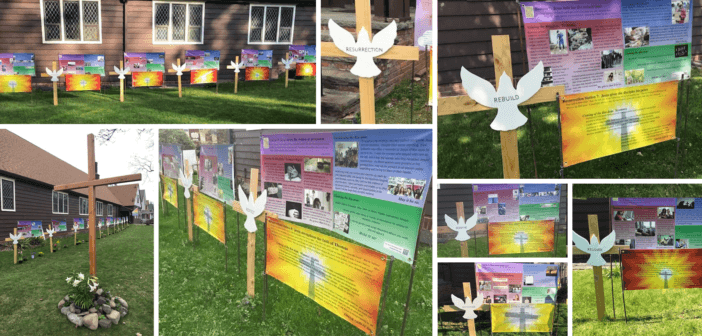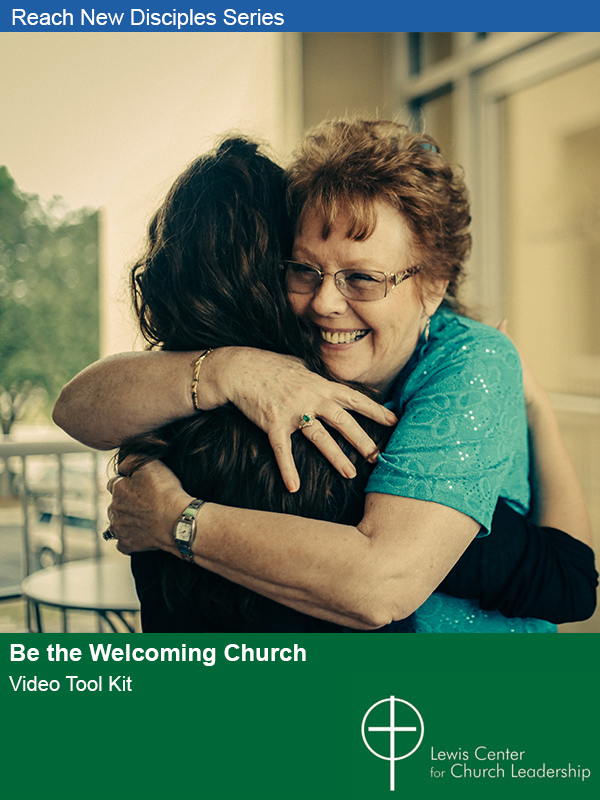Jessica L. Anschutz of the Lewis Center staff reports on one congregation’s unique approach to sharing the Stations of the Cross and the Stations of the Resurrection with its community and beyond. This creative, lay-led effort offers an example of sharing the Good News in visible, justice-oriented ways.
Last year, as the worship team at New Paltz United Methodist Church (NPUMC) prepared for Lent, they were weary and restless due to the pandemic’s ongoing impact on their worship. They were determined to do something fresh that combined scripture with their social justice work. This impulse gave rise to the Social Justice Stations of the Cross and Stations of the Resurrection. Banners were installed on the church lawn directing people to an interactive website. Starting on Ash Wednesday, a new station was released every three days, ending on Palm Sunday. Then, starting on Easter Sunday, a new station was released every three to four days, ending on Pentecost.
Sharing gifts and taking action
Laity at NPUMC have a long history of creating visual worship experiences and writing worship liturgies. The worship team works with the pastor to “tell one story in all the ways we have to tell that story,” says Rev. Limina Grace Harmon, who believes it is the pastor’s responsibility to be the “enabler of justice seekers.”
As they reflected on the different stations, relevant social justice issues bubbled to the surface. Laity took responsibility for writing the content of each station, some working on their own, others in pairs. The visual worship team designed the banners for each station for the church lawn and worked to develop the website.
Putting faith in action
Stations of the Cross identified systems that are power driven rather than Spirit led. Inspiration came from the congregation’s prior studies of two books, White Fragility: Why It’s So Hard for White People to Talk About Racism by Robin DiAngelo and Stand Your Ground: Black Bodies and the Justice of God by Kelly Brown Douglas. Stations of the Cross named the kingdom, envisioned the kin-dom, and claimed the kin-dom. They were designed so that people could accompany Jesus to the cross, confront current social justice issues, and act to create a more just home for all. Stations of the Resurrection proclaimed the “Coming of the Kin-dom” and celebrated the small steps that “move us closer to the Kin-dom God desires for us all.” These stations not only shared the Good News, but helped people know that we can effect change. Kin-dom emphasizes the faith community as the family of God. The term was put forward decades ago by theologian Ada María Isasi-Díaz as an alternative metaphor to kingdom of God.
Location, location, location
Prior to the pandemic, NPUMC was known for its visual displays on the lawn in the days leading up to Easter. The church sits at a well-trafficked intersection only two blocks from the center of town and not far from a public university. The banners on the lawn depicting the stations were highly visible and accessible to the community, especially to families who are a part of the play school at the church.
If your congregation is not in a highly trafficked area, is there a place in your community where the stations could be more prominently displayed? If there are a number of congregations in your community, consider collaborating to develop the stations and spread the stations throughout the community.
Given the ongoing pandemic, the need for a virtual component to Stations of the Cross and Stations of the Resurrection was significant. Those walking the stations on the church lawn were invited to scan the QR code printed on the banner connecting them directly to the website with more information about each station and corresponding justice issue. On the dynamic website, visitors were invited to share additional information and action items about the social justice issues.
Reaching new people
People of all ages, stages, and walks of life explored the stations. The deputy mayor shared the stations on the village social media sites. A few people engaged in ministry with the church through the stations and some neighbors joined virtual worship services after being inspired by the stations. Some neighbors walked the stations each week, with a few starting over at the beginning each week. A lot of people scanned the QR codes and spent time exploring the website, which invited them not only to go deeper, but to take action.
Getting started
Prior to developing the stations, NPUMC spent several years diving deep into justice, exploring what scripture says and how the ancient texts apply today. The laity were well-equipped to develop the stations. A Social Justice Stations of the Cross and Resurrection ministry is dependent upon the culture and context of your congregation. If your congregation isn’t in the same place, begin with a Lenten study of the stations one year, then work on and develop the visual and virtual stations to be launched the following year.
Rev. Limina Grace Harmon is the pastor of New Paltz United Methodist Church in New Paltz, New York. For more information, please visit newpaltzumc.org/events/stations-of-the-cross.
Related Resources
- Easter Vigil Brings the Story of Salvation to a City in Need by Kate Payton
- Taking Church to the Community by Ann A. Michel
- 50 Ways to Take Church to the Community, a free Lewis Center resource







